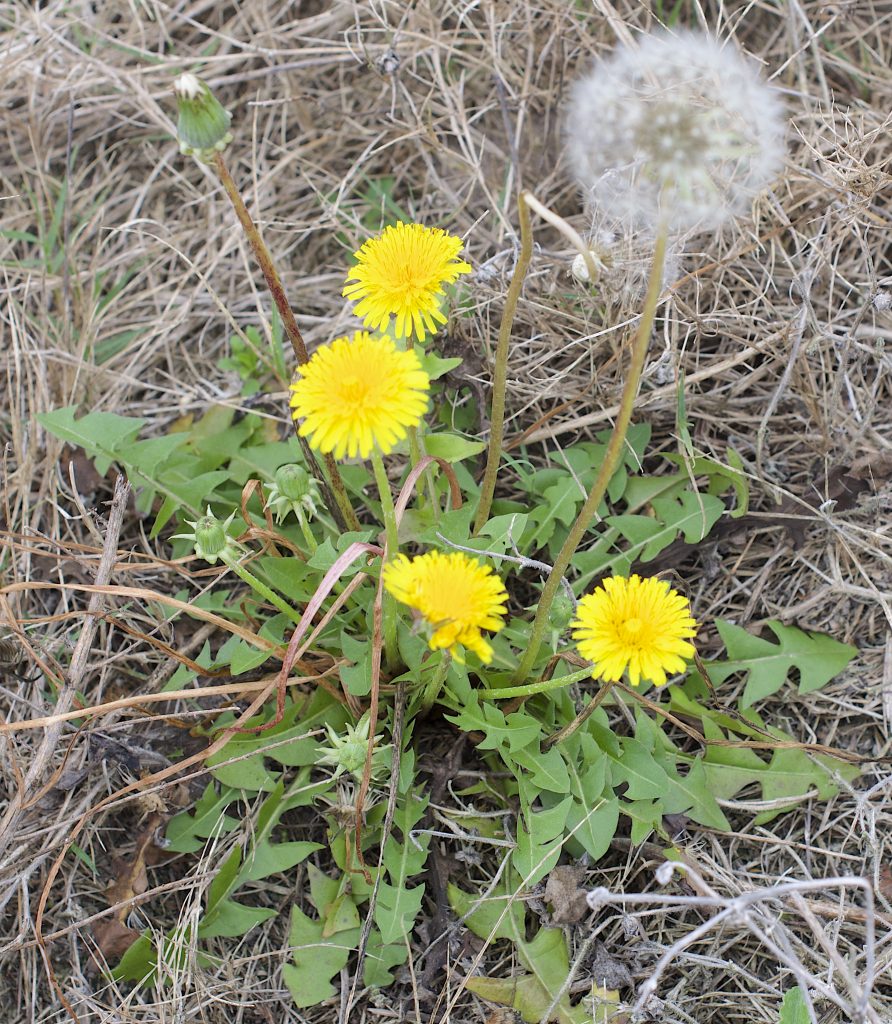
Dandelions hate Florida. They like cool weather and acidic soil. Florida is a hot limestone plate. But as the weather cools we will be seeing more of them. Look in lawn grass under oaks and pines. Nearly all of the Dandelion is edible. Photo by Green Deane
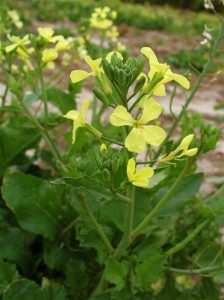
The winter mustards are starting to grow.
While looking for the yellow-blossomed Dandelions above also start looking for the more extroverted yellow-blossomed Wild Radish and Wild Mustard. These two peppery species look very similar and are used the same way. There are several ways to tell them apart but on a glance one identifier of the radish is that it grows in a windrow way whereas mustards tend to grow straight up. Radish blossoms are always yellow, mustard blossoms can be yellow or white. I usually start to find tasty Wild Radishes and Wild Mustards when the nights start getting cooler. To read more about Wild Radish, go here. Wild Mustards click here.
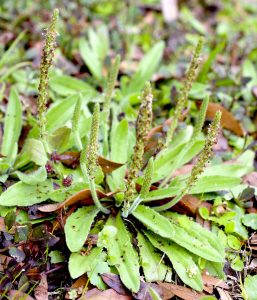
Our native Plantago is small and hairy. Photo by Green Deane
There are Plantains that look like tough bananas and there are Plantains that are low and leafy plants. No relation. Just two different groups with the same common name. Plantains can be native or non-native. The one pictured left is native, the Dwarf Plantain. We saw one Sunday in our foraging class at Mead Gardens. As a genus the plants are well-known. The leaves are edible raw when young. As they age they become more bitter and stringy. Cooking makes them palatable up to a point. Then they move into the astringent medical realm. They are used on bites, stings and to help puncture wounds heal. Seeds are edible once produced and are the source of the commercial dietary fiber psyllium. When finely ground the seeds are sold under the brand name Metamucil. There are numerous species of Plantagos (Plantains) with at least four common locally, P. virginiana, P. major, P. lanceolata and P. rugelii the latter which strongly resembles P. major. They are all used the same way. You can read about the Plantains here.
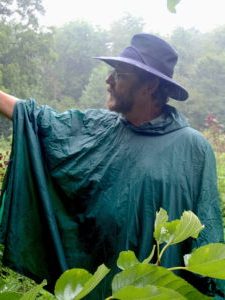
Classes are held rain or shine or cold. (Hurricanes are an exception.) Photo by Kelly Fagan.
Foraging Classes will go ahead despite the weather. On it’s current track Tropical storm Eta should be past us by this weekend. We might have to wear boots and carry an umbrella but the back side of storms are usually fiary tame.
Saturday, November 14th, Florida State College, south campus, 11901 Beach Blvd., Jacksonville, 32246. We haven’t had a class here for several months because of COVID and we’re trying to avoid predicted bad weather that weekend. Meet at Building A next to the administration parking lot. 9 a.m. to noon. This is a pleasant wander around the campus with environments ranging from pond to woods and in between. There are also a good complement of edible ornamentals. We might might find some Lion’s Mane mushrooms.
Sunday, November 15th, Wekiva State Park, 1800 Wekiwa Circle, Apopka, Florida 32712. This class is scheduled only once or twice a year. There is a park admission Fee: $6 per vehicle. Limit 8 people per vehicle, $4 for a single occupant vehicle, $2 pedestrians or bicyclists. Meet at the Sand Lake parking lot. 9 a.m. to noon. Unlike city parks or the urban area, Wekiva Park is “wild” Florida. There are very few weeds of urbanization. The edibles are mostly native plants and far between. This class is recommended for anyone interested in what the natives used. We walk quite a lot.
Saturday, November 21st, Wickham Park: 2500 Parkway Drive, Melbourne, FL 32935-2335. 9 a.m. to noon. Meet at the “dog park” inside the park (turn right after entrance, go 1/4 mile, dog run on right, parking at run or on previous left.)
Sunday, November 22nd, Eagle Park Lake, 1800 Keene Road, Largo, FL 33771. 9 a.m. to noon. Meet at the pavilion near the dog park. Situated in Largo on the Pinellas peninsula it’s a large park with a variety of different environments.
For more information, to pre-pay or to sigh up, go here. It is also time to mark your calendar for my 10th annual Urban Crawl. It will be Friday December 18th at 10 a.m. in Winter Park, Florida. We meet in front of Panera’s. It’s difficult to believe I’ve had that walk for ten years now.
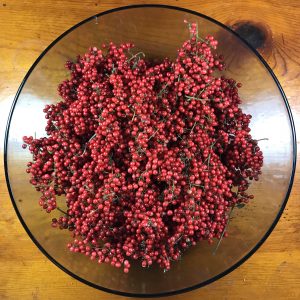
Brazilian Pepper Berries. Photo by Green Deane
Also beginning to fruit fruiting is the controversial Brazilian Pepper. I harvested 17 ounces of them Saturday during our foraging class in Port Charlotte. At one time it was heavily promoted as the “Florida Holly” ignoring that the state has many native hollies. Its berries are often confused with a relative called Pink Peppercorns. In fact “Pink Peppercorns” were banned from the United States for several years because authorities thought they were the same species as Brazilian Pepper. As for using the Brazilian Pepper berries as spice, clearly some people can without any problems. Other people get extremely sick trying them just once. Some people can use them for a few days or weeks without a problem and then get ill. As I tell my students in foraging classes, you’re on your own with this one. So what am I going to to with them? Either one test gallon of wine, or, use them to flavor a gallon or two of mead (as they make a nice honey.) I haven’t made up my mind.
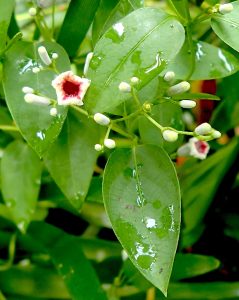
Skunk Vine lives up to its name. Photo by Green Deane
Perhaps as a last gasp — virtually — some Skunk Vine was blossoming this past week (along with some Black Cherries. Skunk Vine is aptly named though its aroma drifts more towards bathroom than skunk. However the tough vine is something of a nutritional powerhouse with some of the good chemicals one finds in the Brassica family. You can eat it raw but if you cook it outside is recommended. Oddly it was intentionally brought to Florida to make rope. This was done just before 1900 when a lot of ships were still carrying sails and miles of rope. Ground zero was the USDA Brooksville Field Station in Hernando County Fl. Yes, this invasive vine — like many other species — was imported by the United States Department of Agriculture. Thirty-six years later it was all over Florida but it took until 1977 for it to be a recognized invasive (long after it had crawled into other southern states.) While the blossoms are attractive we eat only the leaves and young tips. You can read about Skunk Vine here.

Green Deane videos are now available on a USB.
A 150-video USB or 135 video DVD set would be a good winter present and either is now $99. My nine-DVD set of 135 videos has been selling for seven years and are still available. They are the same videos I have on You Tube. Some people like to have a separate copy. A second option is a16-gig USB that has those 135 videos plus 15 more. While the videos can be run from the DVDs the videos on the USB have to be copied to your computer to play. They are MP4 files. The150-video USB is $99 and the 135-video DVD set is now $99. The DVDs will be sold until they run out then will be exclusively replaced by the USB. This is a change I’ve been trying to make for several years. So if you have been wanting the 135-video DVD set order it now as the price is reduced and the supply limited. Or you can order the USB. My headache is getting my WordPress Order page changed to reflect these changes. We’ve been working on it for several weeks. However, if you want to order now either the USB or the DVD set make a $99 “donation” using the link at the bottom of this page or here. That order form provides me with your address, the amount — $99 — tells me it is not a donation and in the note say if you want the DVD set or the USB.

Green Deane Forum
Want to identify a plant? Perhaps you’re looking for a foraging reference? You might have a UFO, an Unidentified Flowering Object, you want identified. On the Green Deane Forum we — including Green Deane and others from around the world — chat about foraging all year. And it’s not just about warm-weather plants or just North American flora. Many nations share common weeds so there’s a lot to talk. There’s also more than weeds. The reference section has information for foraging around the world. There are also articles on food preservation, and forgotten skills from making bows to fermenting food.
This is weekly newsletter #431, If you want to subscribe to this free newsletter you can find the sign-up form in the menu at the top of the page.
To donate to the Green Deane Newsletter click here.


Here where I live in Doha University’s staff campus with my son’s family , despite of the alkaline soil ,Dandellions thrive well among many other weeds, e.g. wild Sweet Potato.The latter seems to like this type of soil. Sir,do’nt you think that this plant has been created to be a symbol to connect people throughout the world ?
Thanks for maintaning the “Eattheweeds” in still in best health. Moreover, l acknowledge the fact that more foragers have been added by learning from it – suffice to mention here my young grand sons and granddaughters : Yousif,Hamoudi,Tarique, Sisso,and Talia.
I’ve sent my comment by e-mamail . I hope you include as suitable.